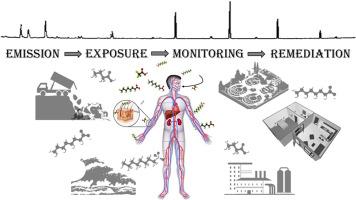当前关于大气中全氟烷基和多氟烷基物质的知识:命运、分析方法和研究重点
IF 8.1
2区 环境科学与生态学
Q1 ENVIRONMENTAL SCIENCES
引用次数: 0
摘要
全氟烷基和多氟烷基物质(PFAS)越来越被认为是普遍存在的大气污染物。反过来,大气是将这些化合物分布到整个环境中的一个重要隔间,使人类通过吸入和/或皮肤接触接触到这些化合物。本研究全面概述了目前关于PFAS的知识,包括:(i)关于排放源的信息汇编-一级源(生产、制造、使用AFFF、废物处理、海洋喷洒)和二级源(中性PFAS的氧化降解);(ii)美国环境保护署ECHA -欧洲化学品管理局(2025)基于蒸汽压对这些物质的挥发性进行的拟议分类;(iii)控制气粒分配、远程输运和沉积的大气过程;(iv)对现有和新出现的抽样和分析技术的评估,包括OTM 45/50方法;(五)识别优先知识差距。在现有的主要差距中,验证改进的监测策略和中性前体的吸入毒性研究可以大大有助于进行强有力的风险评估,并支持逐步淘汰PFAS的不断发展的全球议程中的监管工作。本文章由计算机程序翻译,如有差异,请以英文原文为准。

Current knowledge about per- and polyfluoroalkyl substances (PFAS) in the atmosphere: Fate, analytical methods and research priorities
Per- and polyfluoroalkyl substances (PFAS) are increasingly recognised as ubiquitous atmospheric contaminants. The atmosphere, in turn, is an important compartment for distributing these compounds throughout the environment, allowing human exposure through inhalation and/or dermal contact. This study provides a comprehensive overview of the current knowledge on PFAS, covering: (i) a compilation of information on emission sources – primary sources (production, manufacturing, use of AFFF, waste handling, marine spraying) and secondary sources (oxidative degradation of neutral PFAS); (ii) proposed classifications of the volatility of these substances based on vapor pressure by the U.S. Environmental Protection ECHA – European Chemicals Agency (2025); (iii) atmospheric processes that govern gas-particle partitioning, long-range transport, and deposition; (iv) an assessment of current and emerging sampling and analytical techniques, including OTM 45/50 methods; and (v) the identification of priority knowledge gaps. Among the main existing gaps, the validation of improved monitoring strategies and inhalation toxicity studies for neutral precursors could significantly contribute to a robust risk assessment and support regulatory efforts within the evolving global agenda for the phase-out of PFAS.
求助全文
通过发布文献求助,成功后即可免费获取论文全文。
去求助
来源期刊

Chemosphere
环境科学-环境科学
CiteScore
15.80
自引率
8.00%
发文量
4975
审稿时长
3.4 months
期刊介绍:
Chemosphere, being an international multidisciplinary journal, is dedicated to publishing original communications and review articles on chemicals in the environment. The scope covers a wide range of topics, including the identification, quantification, behavior, fate, toxicology, treatment, and remediation of chemicals in the bio-, hydro-, litho-, and atmosphere, ensuring the broad dissemination of research in this field.
 求助内容:
求助内容: 应助结果提醒方式:
应助结果提醒方式:


